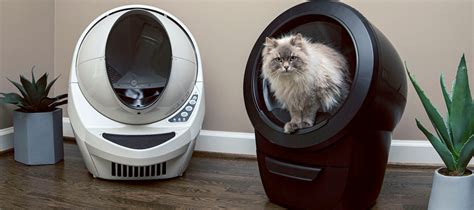A Comprehensive Guide for Cats with Sensitivities
As a thoughtful cat guardian, providing your beloved feline companion with a comfortable and healthy environment is paramount. When it comes to their litter box routine, ensuring their well-being while addressing their sensitivities is crucial. The Litter-Robot, an innovative self-cleaning litter box, has emerged as a potential solution for cats with specific needs. This article aims to delve into the advantages and considerations of using the Litter-Robot for cats with sensitivities, providing insights to help you make an informed decision.

Understanding Cat Sensitivities
Cats, like humans, can experience sensitivities to various substances and environmental factors. These sensitivities can manifest in different ways, including skin irritation, respiratory distress, digestive upset, and behavioral changes. Allergens, such as dust, pollen, and certain perfumes, are common triggers. Other factors that can contribute to feline sensitivities include fragrances, certain litter materials, and even stress.
According to a study published by the American Academy of Allergy, Asthma & Immunology, approximately 10-15% of cats suffer from allergies, with dust and pollen being the most prevalent allergens. Moreover, a significant number of cats exhibit sensitivities to specific litter materials, with clay litter being a common culprit.
The Litter-Robot: A Potential Solution
The Litter-Robot, an automated litter box system, offers several features that may alleviate the challenges faced by cats with sensitivities.
-
Reduced Dust and Allergens: The Litter-Robot’s enclosed design minimizes the dispersion of dust and allergens into the surrounding environment. Its unique rotating globe sifts and separates waste, reducing the amount of dust and dander released.
-
Odor Control: The Litter-Robot’s odor control system helps to neutralize unpleasant smells, creating a more pleasant and healthy environment for both cats and their owners.
-
Low-Maintenance Design: The Litter-Robot’s self-cleaning mechanism removes waste and deposits it into a separate waste drawer, eliminating the need for frequent manual cleaning. This reduces the exposure of cats to dust and allergens accumulated in traditional litter boxes.
Considerations for Cats with Sensitivities
While the Litter-Robot offers several benefits, it is essential to consider specific aspects when using it for cats with sensitivities:
-
Litter Choice: The type of litter used in the Litter-Robot can significantly impact its effectiveness for cats with sensitivities. Avoid using clay-based litter, which can be irritating to cats with respiratory issues. Instead, opt for hypoallergenic litter options such as pine, paper, or corn.
-
Cleaning Frequency: Monitor your cat’s sensitivity and adjust the cleaning frequency of the Litter-Robot accordingly. More frequent cleaning may be necessary for cats with severe sensitivities to ensure minimal exposure to waste and allergens.
-
Veterinary Consultation: If your cat exhibits any signs of discomfort or distress while using the Litter-Robot, consult a veterinarian promptly. Professional advice can help identify underlying health issues and determine the most suitable care approach.
Comparing the Litter-Robot to Traditional Litter Boxes
| Feature | Litter-Robot | Traditional Litter Box |
|---|---|---|
| Dust and allergen control | Enclosed design reduces dust and allergen dispersion | Open design allows for dust and allergen release |
| Odor control | Odor control system neutralizes unpleasant smells | No odor control system |
| Maintenance | Self-cleaning mechanism reduces manual cleaning | Requires frequent manual cleaning |
| Convenience | Less frequent maintenance and litter refills | More frequent maintenance and litter refills |
| Customization | Allow for adjustment of cleaning frequency and litter type | Limited customization options |
| Cost | Higher initial investment | Lower initial investment |
| Health benefits | May alleviate sensitivities by reducing dust, allergens, and odor | May contribute to sensitivities due to dust, allergens, and odor |
Market Insights and Innovations
The market for self-cleaning litter boxes, including the Litter-Robot, is growing rapidly as pet owners seek solutions to improve the well-being of their feline companions. According to a report by Grand View Research, the global automated litter box market is projected to reach $1.4 billion by 2025.
Innovation in the self-cleaning litter box industry is ongoing, with a focus on developing features that enhance convenience, health, and safety. For example, some Litter-Robot models now offer smartphone integration, allowing remote monitoring and control of the device.
Case Study: Oliver’s Sensitivity Relief
Oliver, a 5-year-old domestic shorthair, had been struggling with respiratory issues for several months. Tests revealed that he was allergic to dust and other allergens common in the environment. His owner, Sarah, had tried various litter boxes but found that the dust and odor from traditional litter exacerbated Oliver’s symptoms.
After consulting with her veterinarian, Sarah decided to invest in a Litter-Robot. Within a few weeks, she noticed a significant improvement in Oliver’s overall health. The Litter-Robot’s enclosed design and dust-reducing features effectively minimized his exposure to allergens. Additionally, the self-cleaning mechanism kept the litter box clean and odor-free, further reducing the triggers for Oliver’s allergies.
Sarah was thrilled with the positive impact the Litter-Robot had on Oliver’s life. She attributed his improved health and well-being to the product’s innovative design and allergen-reducing features.
Conclusion
The Litter-Robot offers a potential solution for cats with sensitivities, reducing their exposure to dust, allergens, and odor. However, it is essential to choose the right litter type and adjust the cleaning frequency based on your cat’s specific needs. If your cat exhibits signs of discomfort or distress while using the Litter-Robot, consult a veterinarian for professional guidance.
As the self-cleaning litter box market continues to evolve, expect further innovations that cater to the comfort, health, and convenience of cats and their owners.





















